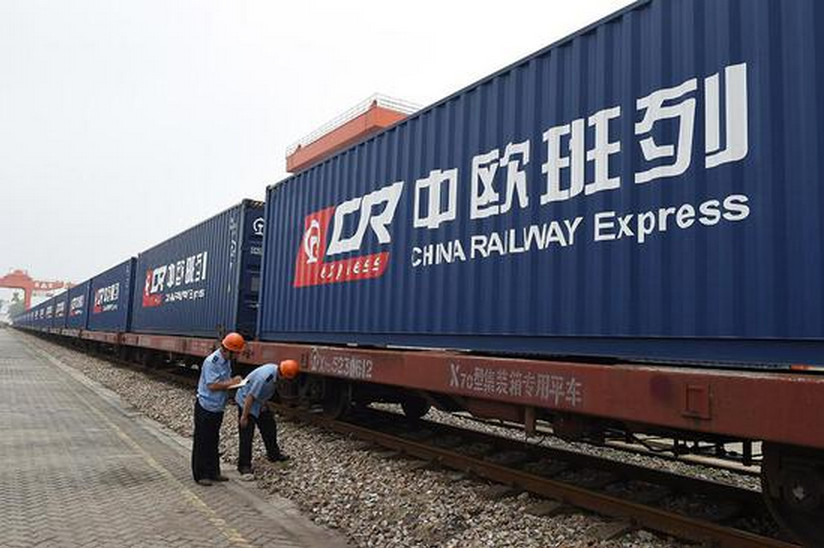Lehmann: ‘B&R’ presents new vistas for world economy

Departing from Yiwu in eastern Zhejiang Province, a China-Europe freight train passes through Kazakhstan, Russia, Belarus, Poland, Germany, Belgium and France before arriving in London. The “Belt and Road” initiative contains a number of infrastructure projects aimed at promoting transcontinental connectivity and trade.
LONDON—Since it was launched in 2013, China’s “Belt and Road” initiative has become an object of fascination and speculation for academics in Europe. Recently, Jean-Pierre Lehmann, an emeritus professor of international political economy at the International Institute for Management Development in Lausanne, Switzerland, talked about its economic implications with CSST.
CSST: How might the “B&R” help restructure the Chinese economy and create new avenues of growth?
Lehmann: Over the last three decades, China rapidly achieved the rank of second-biggest economy and became a major power in world trade. Though China’s main competitive advantage lay in low-value-added mass production, recent years have seen the emergence of highly innovative tech-leaders. Furthermore, while China was highly successful in attracting inbound foreign direct investment, more recently, through outbound FDI, it has become a global force in greenfield investments, and mergers and acquisitions.
The initial growth model, as impressive and successful as it was, has reached a state of maturity. For China to escape the middle-income trap and become a high-income economy “driven by creativity and the power of ideas,” the model needs refurbishment. The “B&R” offers a tantalizing new perspective on the Chinese, Eurasian and, indeed, world economies. If properly managed, it will provide forceful feedback loops enabling the generation of new products, new technologies and new markets.
CSST: How might the initiative stimulate cross-border trade and economic development along the vast area it covers?
Lehmann: There is no doubt that the “B&R” initiative presents new vistas. Regions of Eurasia that have genuinely and successfully participated in the global market are Western Europe and East Asia (both Southeast Asia and Northeast Asia), and to a more limited extent, parts of South Asia. Vast swathes of the Eurasian continent remain peripheral to and indeed marginalized within the global market. These include: Central and West Asia and Eastern Europe. If Central and West Asia, or the “Greater Middle East” as it is also called, could “do an ASEAN” and transform from battlefields into market places, the world would be far, far better, more prosperous and peaceful. The “B&R” initiative may help achieve these ends. Its combined land routes and the maritime route herald a new age of discovery. While it is for now a vision, with some accomplishments, there can be no doubt that there will be tremendous challenges and obstacles of all kinds. For example, inefficiencies and costs may arise due to deficiencies in infrastructure and administration. Therefore, a lot needs to be done to enhance performance and prospects.
CSST: What specific implications will the initiative have for Europe?
Lehmann: In history, goods were traded along the old Silk Road, so were ideas, religions, arts, and scientific discoveries and technologies. Civilizations across the Eurasian continent converged and enriched each other. All regions of the Eurasian continent would greatly benefit from a greater degree of exchange and integration, not just in terms of markets, but also in terms of cultures. Thus the “B&R” initiative, by generating and opening up new markets and new business opportunities in areas including infrastructure, logistics, finance, tourism, digital trade, artistry, architecture, museums, could provide a significant boost to growth and entrepreneurialism. The “B&R” initiative has the potential to create not only a Eurasian market but also a Eurasian community of arts, sciences and ideas.
CSST: Some suggest that the United States should embrace the initiative, too. What benefits might the initiative have for the US?
Lehmann: The “B&R” initiative is an example where the United States should actively seek to engage China. The United States has very significant interests and investments in many countries of the Eurasian continent, and these stand to benefit from the “B&R” initiative. It would especially benefit if the hoped-for transformation of Central and West Asia from a battlefield into a marketplace were to occur.
CSST: Some experts say the initiative might become the biggest economic development project in history. How can its immense potential be unleashed?
Lehmann: The potential benefits to global trade and the global economy of the “B&R” initiative are absolutely very significant. New markets, new products, new technologies, new opportunities or indeed the greater development of current opportunities, arise. But there are significant challenges, obstacles, and risks: economic, financial, environmental, technological, logistical, political and geopolitical.
At the moment, China has achieved quite formidable global “hard” power–economic and increasingly military—but it remains weak in global “soft” power. Ultimately, for the “B&R” initiative to succeed, China needs to enhance, improve and promote its soft power quite dramatically.
The “B&R” initiative has tremendous economic potential for Eurasia and the world, but if it is seen only through an economic prism, only as an exercise in hard power, it will hardly succeed. China’s soft power has enormous potential. Chinese leaders need to “market” the initiative along soft power lines.
Jiang Hong is a reporter at the Chinese Social Sciences Today.
